The human brain coordinates our perceptions, thoughts, and actions through its neuronal activities. Neuroscientists are trying to understand the function of the brain by adopting methods that can separate, identify, and manipulate neurons with single neurons and unimodal resolution during behavior.
Neural probes have been successful not only in extracellular recordings, brain-machine interface (BMI) and deep brain stimulation (DBS), but also in some new applications such as electroencephalography, neuronal function recovery, and brain disease research. Awesome. Ideally, the neural probe array should have good biocompatibility, a high-density electrode with a high signal-to-noise ratio, interconnect functions via a flexible cable, a highly integrated electronic architecture, and an integrated microactuator. Drive electrode handles to achieve neuron motion tracking.
In order to be able to record a single neuron on a large scale in multiple regions of the brain, neural probes require high density, large numbers of electrodes. Unfortunately, the latest high density CMOS neural probes have a large "handle" that is part of the probe and will be implanted into the brain area. This "handle" part needs to be as thin as possible to avoid interfering with or impairing normal brain function. At the moment, they are still not as small as neuroscientists hope.
In addition, the current electronic design architecture is not the best. The probe design consists of a large number of small active electrodes for amplifying and buffering nerve signals. The CMOS pixel amplifier (PA) is located in a very small space below the electrodes. Due to lack of space, signal processing is forced to complete on the base of the probe. Imagine the noise problem in such non-ideal signal routing. Ideally, it is desirable that the signal processing be performed next to the PA.
Micro Optomechanical (MOM) Pressure Sensors
We started with pressure sensor design. MEMS pressure sensors are capacitive and piezoelectric, they are small and their performance is quite good. Then there are fiber-optic sensors, which have super-sensitivity and low noise characteristics, but are best used in less integrated design architectures.
Now, we combine the above two sensor characteristics into one integrated sensor, a micro-opto-mechanical (MOM) pressure sensor. Compared to piezoelectric and capacitive sensor designs, this device offers higher sensitivity and better noise characteristics, but the package size is the same.
The MOM device is demonstrated using a Mach-Zehnder interferometer (MZI) system or a ring resonator (Figure 1).
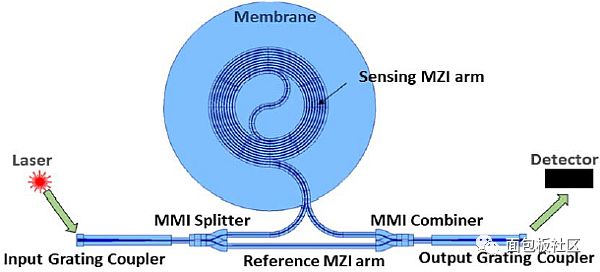
Figure 1: Unbalanced Mach-Zehnder interferometer layout with grating coupler, multimode interferometer (MMI) splitter and helical waveguide arms.
As shown in Figure 1, a typical MZI MOM pressure sensor consists of an MMI splitter, two waveguide arms, and an MMI combiner. This design places one of the MZI arms on a flexible membrane (Figure 2) to withstand differential pressure; the other MZI arm serves as a fixed reference. A trade-off is made when determining the number of loops in a spiral in a design: Increasing the number of loops will increase sensitivity, but it will reduce the pressure range, and vice versa.
Functionally, the intensity of light emitted from the MZI depends on the phase difference between the two arms and the differential pressure it experiences. Because one of the arms is much longer than the other, the MZI is "unbalanced."
In the process of manufacturing the device, a sensing film was created. As the film bends, the position of the waveguide changes, causing the optical path to extend, causing the particular arm to phase shift (Figure 2).
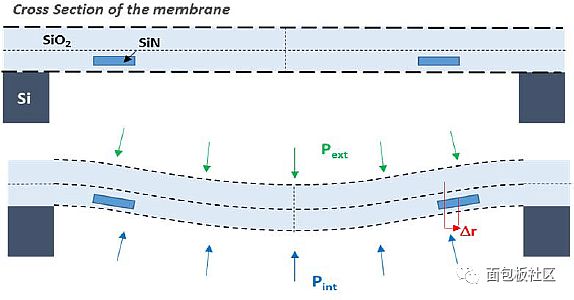
Figure 2: In this miniature optical pressure sensor cross section, the lower half shows the bending under pressure.
laser
Spectral bandwidth is an important parameter that greatly affects the sensitivity of the laser. The implementation of balanced MZI will consider this effect.
Laser output produces noise due to quantum noise and changes in the laser cavity. Intensity noise and wavelength drift are two important noises. Intensity noise can be corrected by adding a power tap that directly subtracts the noise from the signal. Wavelength drift can be reduced by adding filters (such as ring resonators) at the input of the circuit.
Modified design
Improved MOM pressure sensor design, MZI is balanced; the first is a single loop for a wide range of measurements, the second splits the signal in the sensitive spiral arm into two phase-out outputs, so that each pressure can be performed at all times. Sensitive measurement (Figure 3).
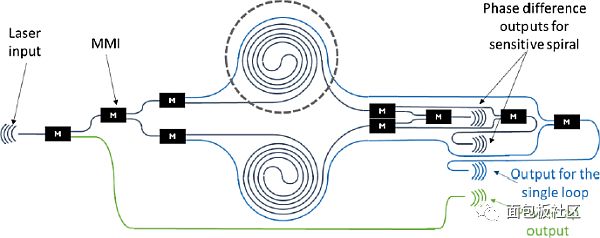
Figure 3: Improved MOM pressure sensor.
Neural probe
A good active neural probe will buffer/amplify the input signal as close as possible to the source/electrode to enhance the signal for optimal recording quality. This method reduces the source impedance and minimizes crosstalk caused by nearby long-handle wire coupling effects.
The area of ​​the PA is limited by the size of the electrode. Its power is limited by acceptable tissue heating limits. The noise needs to be lower than the minimum signal amplitude (which may be as low as tens of microvolts). In general, a simple way to reduce noise is to provide more current for the PA transistor, which will also bring higher bandwidth.
The signal bandwidth of the neural probe is approximately 7.5 kHz and the PA output can be sampled using 15 kHz. Designers have discovered that time-division multiplexing can be embedded in the handle (Figure 4a). This can be done with M PA outputs on each unique handle. If no anti-aliasing filter is added, the PA bandwidth will produce in-band noise due to folding. It is not possible to load a low-pass filter into this small PA area before sampling occurs. The designer chose to use an architecture that can integrate the signal during the Ti period (Figure 4b) to attenuate the signal that exceeds the sampling frequency fi, thereby increasing the signal-to-noise ratio (SNR).
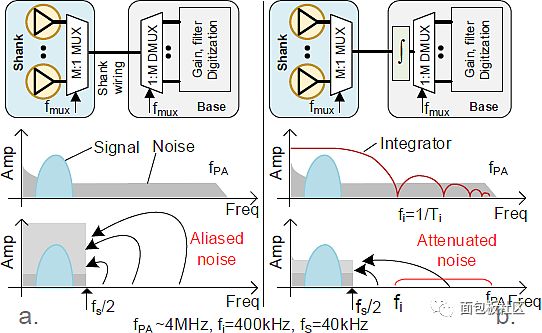
Figure 4: (a) shows what happens when the circuit is multiplexed without a filter; (b) shows that filtering the signal through integration reduces the out-of-band noise level.
The signal flow in the probe architecture design (Figure 5) flows from the output of the 8 multiplexed PA arrays through a shared handle line to the pedestal. The signal then enters the integrator in the probe pedestal, and the output of the integrator is demultiplexed by eight sample-and-hold circuits labeled Vo. Next, each of the 8 individual Vos enters their own channel module, which amplifies and filters the signal so that the output only has the frequency band of interest. Next, all 20 channels are multiplexed and digitized by a 10-bit successive approximation register (SAR) analog-to-digital converter (ADC) and sent to an ADC and multiplex/demultiplexer (MUX/DEMUX) A digital control module that provides the clock. Here, the parallel output of all ADCs is serialized with only 6 data lines.

Figure 5: Probe architecture design and signal flow with pseudo-differential signal paths from input to output.
Pixel Amplifier (PA)
It is very creative for designers to design their PA architecture into two areas. PA is essentially a voltage-to-current converter (Figure 6).
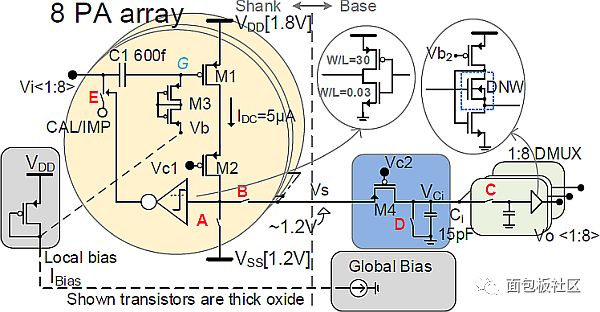
Figure 6: Pixel Amplifier Architecture.
Figure 6 shows that the output current of the voltage-to-current converter is integrated by the capacitor Ci for 2.5μs, then sampled and moved to the demultiplexer.
Ultimately, this design architecture achieves at least a 2x increase in the number of simultaneous recording channels compared to existing state-of-the-art probes.
I fully expect that there will be an endless stream of architectural advancement in the electronics field in the future. Medical electronics will greatly benefit from MEMS and sensors and other architectural advances, coupled with semiconductor innovations that will help improve the lives of patients and health and fitness people. Let us use engineering technology to make the world a better place and people healthier.
Power cord can be used in wide range of industries. Home appliances, charging equipment, lighting, Gym appliance, computer, tool, pump, compressor, medical equipment, and so on. All products which are driven by electricity need a power cord.DC (direct Current) power cord is used to the applicance with lower voltage mostly, so safety requirement is less stringent.
DC Power Cord, power cable, DC cable, power connector
ETOP WIREHARNESS LIMITED , https://www.oemwireharness.com
![<?echo $_SERVER['SERVER_NAME'];?>](/template/twentyseventeen/skin/images/header.jpg)